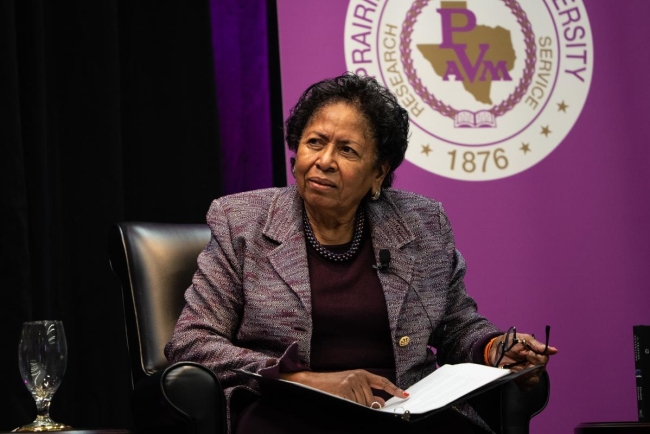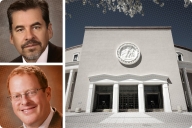You have /5 articles left.
Sign up for a free account or log in.

Ruth Simmons, pictured here at Prairie View A&M University in the fall, resigned from the presidency last month over limitations on hiring powers.
Nicholas Hunt/Office of Marketing and Communications/Prairie View A&M University via Getty Images
When Ruth Simmons assumed the presidency of Prairie View A&M University in 2017, it was considered a major boost to the historically Black university. She brought to the role decades of leadership experience, including stints as the president of Smith College and then Brown University, where she became the first Black president to lead any Ivy League institution.
Prairie View A&M hired Simmons, then 71, in an interim capacity, luring her out of retirement for the job, which eventually became permanent. She has been credited with improving fundraising and student outcomes at Prairie View A&M.
But now, six years later, Simmons has left her post several months ahead of a planned June departure, resigning in protest over a Texas A&M University system policy that bars presidents of system colleges such as Prairie View A&M from hiring permanent cabinet members when they are on their way out.
System officials have stressed that the policy has been in place for decades; Simmons said she refused to be limited in her capacity to do her job before her scheduled departure in June, leading her to officially exit the presidential role last week. But outside observers—and other college presidents—say it makes sense to defer certain hires, given that the new president would understandably prefer to work with their own chosen cabinet.
The Prairie View A&M Dustup
When Simmons announced her early departure last month, she didn’t mince words, suggesting Texas A&M system officials told her “she could only continue as president with limited presidential authority.” Specifically, Simmons raised a complaint about limitations on hiring.
“My immediate response was that I could not and would not agree to being president in name only. No enduring good can arise from subservience to low standards and expectations,” Simmons said in a statement announcing her departure. “I will support the efforts of faculty, staff and students who seek the best for themselves and their university. We must not be held hostage to how others choose to see us or treat us, but, instead, continue to chart our own path demonstrating the pride, commitment and integrity that defines us.”
John Sharp, chancellor of the Texas A&M system, responded with a statement of his own, flagging system policies on presidential hiring powers.
“When Presidents in The Texas A&M University System announce they are leaving, they cannot hire senior staff or Deans except on an interim basis, so that the new President can choose the leadership team he or she will be working with during their term,” Sharp said on the same day Simmons announced her early exit. “This decade-long policy applies to all of our Presidents.”
Sharp pointed to previous examples at Texas A&M University, as well as Prairie View A&M, stating that Simmons’s predecessor had the same limitations when she was hired in 2017.
(Both Simmons and Sharp declined interviews with Inside Higher Ed.)
It is unclear which role Simmons was unable to fill during her last days as president, but the job openings on Prairie View A&M’s job board include a current listing for a dean to lead the College of Juvenile Justice and the Texas Juvenile Crime Prevention Center.
Outgoing-President Hiring Norms
While Texas A&M system policies prevent outgoing presidents from hiring full-time executives to top positions, some presidents choose to defer those hiring powers to their successors. That’s what Lawrence Bacow chose to do at Harvard University; he told The Harvard Crimson that he would leave the filling of four vacant dean positions to incoming president Claudine Gay, who will formally begin the job this summer. Bacow said a similar process also played out when he was hired as president.
(Harvard declined to comment on Bacow’s decision to defer hiring powers to Gay.)

Higher education observers note that some colleges, such as Harvard, extend hiring powers to incoming presidents as a matter of custom, while others, such as the Texas A&M system, do so based on standing policies. The former approach, they suggest, is more common—and usually the right thing to do.
“I think it isn’t fair to individuals that you hire into a permanent position if they are hired by an individual who leaves that position, and they suddenly find themselves with a new boss,” said Sally Mason, a senior consultant and senior fellow for AGB Consulting and president emerita at the University of Iowa. “That doesn’t always work. It can, it’s great when it does, but it might not.”
It’s also important, Mason said, to allow new presidents the opportunity to choose their cabinet. She added that not allowing new presidents to choose their cabinet puts them at a disadvantage.
“It’s not fair to whoever might be selected as the next president,” Mason said. “It is often a wonderful opportunity for a new president to be able to select a team that he or she is going to be working with, hopefully, for the foreseeable future, and one that can come together around the new president’s priorities that perhaps are different than the previous president’s priorities.”
Armand Alacbay, chief of staff and senior vice president of strategy at the American Council of Trustees and Alumni, offered a similar perspective.
“There’s a certain logic in deferring to the incoming administration in selecting their team,” he said. “The overarching charge is to ensure … as smooth of a transition as possible.”
He also noted that it may be harder for an outgoing president to find top talent for cabinet positions, given that the new hires know they will be under the authority of a new boss in short order.
But “every situation is different,” Alacbay added; some presidents have longer off-ramps than others. For example, if an interim president is serving for two years, it makes more sense for them to fill top positions rather than leave those vacant and defer hiring to the next leader.
Meanwhile, despite the dramatic exit, both Simmons and Prairie View A&M have moved on.
Simmons was named a president’s distinguished fellow at Rice University and a senior adviser to the president of Harvard on engagement with historically Black colleges and universities. Both announcements came shortly after Simmons stated she would be leaving the Prairie View A&M presidency early.
Texas A&M system officials have since appointed Michael L. McFrazier as acting president of Prairie View A&M, temporarily elevating him from his role as dean to serve as a stopgap interim. Prairie View A&M’s next president, Tomikia P. LeGrande, will officially step into the job on June 1.








